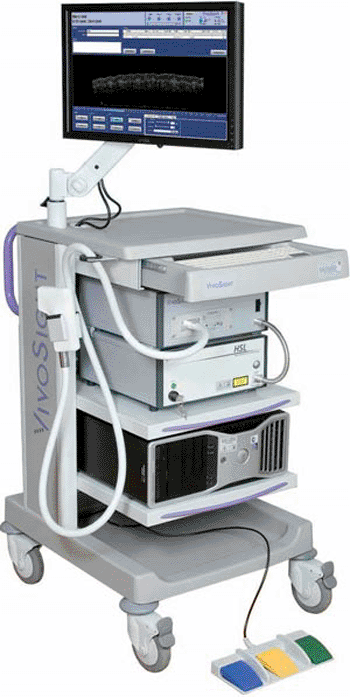Optical Coherence Tomography Shown to Predict Tumor Margins Effectively
By MedImaging International staff writers
Posted on 28 Jan 2013
A precise determination of tumor margins is vital for the effective treatment of skin cancer patients. This is particularly true for patients undergoing Mohs micrographic surgery, where complete tumor removal may require repeated invasive procedures.Posted on 28 Jan 2013
Recent studies conducted in two US Healthcare facilities used the VivoSight optical coherence tomography (OCT) scanner, manufactured by Michelson Diagnostics, Ltd. (South London, UK), to prospectively improve clinically estimated tumor margins prior to Mohs micrographic surgery.

Image: The VivoSight optical coherence tomography (OCT) scanner (Photo courtesy of Michelson Diagnostics).
The first, a 52-patient study, conducted by Prof. Dan Seigel, from the department of dermatology, State University of New York Downstate Medical Center (Brooklyn, NY, USA), concluded that “OCT assessment has the potential to reduce the excised area without compromising the integrity of tumor-free borders.” The study’s findings were published January 2013 in the journal Dermatologic Surgery.
Another case study of a patient with very ill defined margins concluded that, “High-resolution imaging with a multibeam OCT device can accurately predict tumor margins of a BCC prior to Mohs micrographic surgery […] with any tumor, particularly ill-defined ones, the use of OCT could potentially reduce the number of stages required to clear the tumor leading to shorter operative times and reduction of cost.”
The findings were published December 2012 in the journal Case Reports in Dermatology by researchers from the Permanente Medical Group (Elk Grove, CA, USA) and SkinCare Physicians (Chestnut Hill, MA, USA).
Dr. Gertraud Kraehn-Senftleben, a dermatologists from Blaubeuren, Germany, and a member of the German Onkoderm Network, and one of the first clinicians to use the VivoSight OCT scanner in routine clinical practice, commented, “These studies reflect the day to day experience in our clinic. We routinely scan tumor margins prior to micrographic surgery and our experience of more than 150 patients is that it reduces the amount of repeat surgery required. This is a great benefit for both the patient and the dermatologist.”
Related Links:
Michelson Diagnostics
State University of New York Downstate Medical Center
SkinCare Physicians














